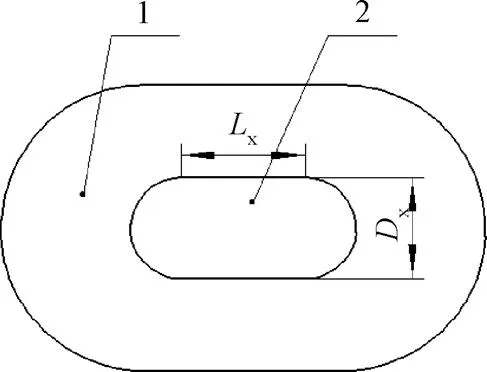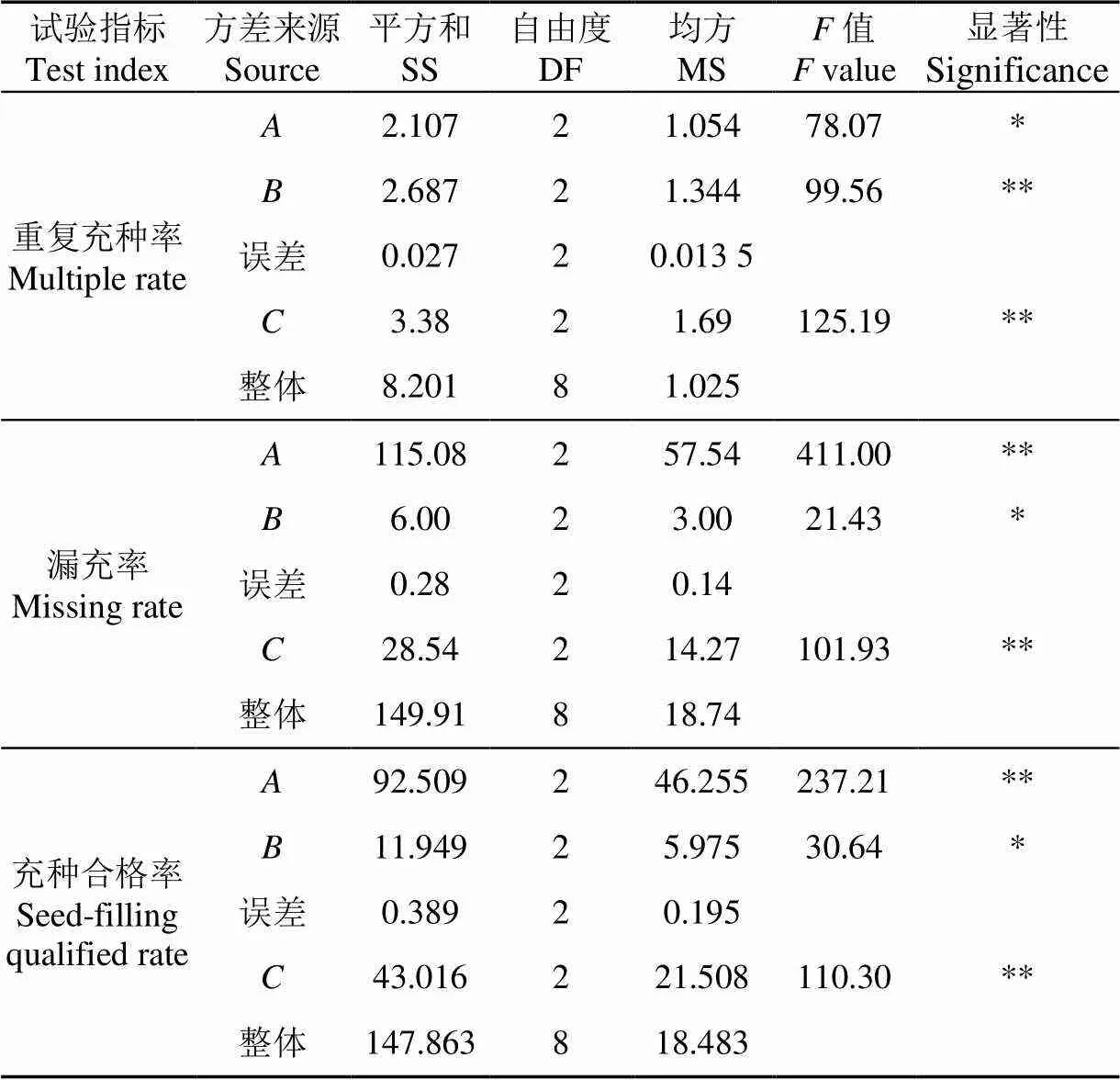气吸型孔组合式小麦精密排种器设计与参数优化
2019-01-14程修沛卢彩云孟志军于佳杨
程修沛,卢彩云,孟志军,于佳杨
气吸型孔组合式小麦精密排种器设计与参数优化
程修沛1,卢彩云1,孟志军2,于佳杨3
(1. 中国农业大学工学院,北京 100083; 2. 北京农业智能装备技术研究中心,北京 100097; 3. 北京海虹嘉诚知识产权代理有限公司,北京 100080)
针对当前小麦籽粒小、播量大、形状不规则,传统排种器难以实现精密播种等问题,该文设计了一种气吸型孔组合式小麦精密排种器。排种器采用气流-型孔组合式工作原理,气流负压吸种与型孔充种相结合能够使其获得良好单粒充种性能。根据小麦精密播种的粒距要求和三维尺寸,通过理论分析,确定了排种器的型孔轮半径为50 mm,以6°螺旋升角布置三排型孔,每排30个型孔,型孔为长槽形,长、宽、深分别为8.5、5和2.5 mm;通过流场分析,研究了不同吸孔孔径对气流变化的影响,确定了吸孔的孔径范围1.4~1.8 mm。搭建试验台,以气流负压、吸孔直径和型孔轮转速为试验因素,以重复充种率、漏充率和充种合格率为试验指标,进行三因素三水平正交试验,并分析各试验因素对于性能指标的影响显著性。通过极差和方差分析,得到气吸型孔组合式小麦精密排种器较优的组合参数为负压3 500 Pa、吸孔直径1.6 mm、排种型孔轮转速40 r/min时,进行试验验证,其重复充种率为5.1%、漏充率为4.7%,充种合格率为90.2%。该排种器能够满足小麦的精密排种对充种性能的要求,在一定程度上促进了小麦精密播种的发展。
机械化;农作物;设计;气吸型孔组合式;精密排种器;小麦;充种;试验
0 引 言
小麦是中国的主要粮食作物之一,据2017年中国统计年鉴数据显示,全国小麦种植面积约为2 418.7万hm2,产量12 884.5万t[1],对国家粮食安全和社会稳定具有重要的影响。但中国小麦传统播种主要方式为撒播和条播,存在着播量高、水肥施用量大等问题,致使群体密度大、个体吸收养分和光照不足,易倒伏且穗粒小,严重限制了小麦单产的提高[2-3]。小麦精密播种技术作为一种先进的农作物种植方法,改变传统条播堆积的作业方式,精确控制播量、粒距和田间分布均匀性,使得单株作物能够充分高效利用水、肥、光、气等自然资源,在降低播种量、减少成本的前提下,保证小麦的高产稳产[4-6]。
精密排种器是实现精密播种的关键部件之一,直接影响了精密播种作业效果[7-10]。目前,小麦排种器以外槽轮式为主,依靠重力和种子之间摩擦力进行充种、排种作业,充种随机性强、排种脉动性高、稳定性差,易出现缺苗断垄或集堆拥挤的现象[11],难以实现小麦的精密排种。而现有精密排种器的研究和应用多以玉米、大豆等大粒种子为主[12-16],小籽粒、经济作物等精密排种方面也逐渐在开展研究[17-18]。
近些年,小麦精密排种方面研究较少,仅有少数学者开展了尝试和试验研究。Wintersteiger公司[19]研制了一种基于径向槽排种盘和螺旋槽排种盘的组合式小麦精密排种器,应用于小区小麦育种试验,但作业速度低、结构复杂、价格昂贵,难以适用于大田小麦精密播种作业;大田作业中,国外多以气力集排式排种器应用于大幅宽的小麦精量播种机,通过气流对落种进行重新分配到各行,播种效果比外槽轮式排种器有较大提高[20-21]。王瑞雪等[22]设计了一种双吸盘小麦精密排种器,改进传统气吸式精密排种器结构,并进行二次回归正交试验,分析了各因素对于排种效果的影响;赵晓顺等[23]研究了负压式小麦精量排种器,采用吸种环槽形式,并通过台架试验确定其较优的结构参数;梁素钰等[24]对小区用小麦精密排种器进行改进,并通过性能试验分析其可行性。上述研究在理论或试验平台上做了有益的探讨,为后续小麦精密播种技术的发展奠定了基础,但存在着结构复杂、充种效果差、排种性能稳定性不高等问题,与大田作业的小麦精密排种要求还存在一定的差距。
本文研究了一种气吸型孔组合式小麦精密排种器,采用气流-型孔相结合的工作原理,以解决小麦籽粒小、形状不规则所引起的充种效果差、排种性能不稳定等问题,改善充种效果,获得良好的充种性能,以期为小麦精密排种器的研究和发展提供参考。
1 整体机构与工作原理
1.1 排种器结构
气吸型孔组合式小麦精密排种器主要由种盒固定架、排种盒、隔种清种刷、传动轴、型孔轮、导种板等组成,如图1所示。其中,传动轴由实心段和空心段组成,靠近链轮一侧为实心段,另一侧为空心段,空心部分的排种轴、型孔轮以及左右封闭部件组成密闭的吸种室;排种盒内安装有导种板,起到种子定向作用;隔种清种刷与型孔轮之间有一定的距离,能够清除多余的种子;型孔轮上布置有型孔、吸孔和投种槽;排种盒下方的圆弧面上布置的投种片和型孔轮上开有的投种槽共同配合作用完成投种作业。

1.固定架 2.排种盒 3.隔种清种刷 4.型孔轮 5.传动链轮 6.传动轴 7.进气口 8.导种板
1.2 工作原理
气吸型孔组合式小麦精密排种器在作业过程中,根据功能的不同主要分为5个区域,分别为充种区、清种区、导种区、投种区和过渡区,如图2所示。电机作为动力源,通过传动链轮驱动排种器转动,负压风机通过管道与空心排种轴相连,型孔轮内部的真空吸室产生负压,从而使型孔轮内外侧形成压差;种子落入种盒过程中在导向板的导向作用下,按长轴方向平行于型孔轮径向排列,位于型孔轮的充种区;工作时,在充种区,种子在自身重力以及型孔轮的摩擦力下落入型孔,并在型孔轮内外气压差作用下被吸附;当种子旋转经过清种区时,隔种清种刷与型孔轮距离较小,不足以使并列充入型孔的多粒种子通过,型孔内在已充入一粒种子后,多余种子在隔种清种刷的阻挡作用下留在充种区,使得型孔内保留一粒种子;种子离开清种区后进入导种区,此阶段小麦种子在吸孔气吸的吸附力作用下进行稳定输种;到达投种区后,插入投种槽的投种片阻断了种子的去路,投种片推力克服了内外气压差所形成的吸附力,将种子推出型孔,并在重力作用下完成投种过程;随后型孔转至过渡区,准备下一轮充种、排种作业。

Ⅰ.充种区 Ⅱ.清种区 Ⅲ.导种区 Ⅳ.投种区 Ⅴ.过渡区
2 关键结构设计与参数分析
小麦精密播种要求播后小麦以规定的行距、粒距和播深在田间合理、均匀分布,使每一粒种子在土壤中拥有足够的空间,能够更好的吸收土壤中养分,提高对阳光和水分的利用率。本文针对传统外槽轮排种器存种脉动性、播后均匀性差、易堆积等问题不能实现小麦精密播种,本文以小麦三维尺寸为基础,进行小麦精密排种器的设计。
2.1 小麦三维尺寸
小麦种子的三维尺寸是型孔轮等结构参数设计的参考基础,因此为了后续确定型孔轮的结构参数,以京冬22号为研究对象,随机选取100粒种子测量其长、宽、厚3个方向上的外形尺寸,结果如表1所示。

表1 小麦三维尺寸
经过测量,小麦种子长度范围5.4~7.8 mm,宽度范围2.4~4.2 mm,厚度范围2.6~3.7 mm,各方向尺寸具有一定范围,但尺寸基本符合正态分布;由表1可知,小麦种子平均长度6.8 mm,平均宽度3.4 mm,平均厚度3.0 mm,小麦的宽度与厚度较为接近,约为长度的二分之一。因此,小麦种子能够简化为椭球体,便于后期排种器关键结构的设计和参数确定。同时,小麦的三维尺寸对于小麦精密排种器的结构参数有一定的影响,当不同品种之间三维尺寸相差较大时,其参数应根据所播小麦品种尺寸进行设计,并尽可能的增大适应性。
2.2 小麦精密排种粒距的确定
小麦精密播种使种子以一定的行距、粒距和播深播入田间,在行距确定、播深一致的情况下,小麦播种粒距取决定于小麦播量。
小麦粒距指相邻2粒种子的距离,计算公式为

式中1为排种粒距,cm;为每公顷播种长度,m;为每公顷播种粒数;为公顷面积,10 000 m2;为行距,m;为公顷播种量,kg/hm2;1为千粒质量,kg。
由小麦粒距计算式(1)可知,小麦粒距与播种量成反比,播量越大,粒距越小,在其他参数固定的情况下,粒距的大小主要由播量所决定。根据小麦精密播种的种量要求,取90~120 kg/hm2,行距0.2 m,千粒质量0.04 kg,计算可得小麦粒距范围1.67~2.22 cm。小麦精密排种粒距的计算,为后续的型孔个数和分布的设计提供依据。
2.3 型孔轮设计
型孔轮是气吸型孔组合式小麦精密排种器的核心部件,其设计与参数是否合理对于整个排种器的排种性能具有重要的影响。型孔轮布置有用于充种的型孔,型孔中心设置用于吸附种子进行稳定携种、输种的吸种孔,以及配合清种的投种槽,结构如图3所示。型空轮的主要参数包括型孔轮半径、型孔尺寸与排布、吸孔的形状与尺寸等,这些参数是保证充种、携种和投种的关键。

1.型孔 2.吸孔 3.投种槽
2.3.1 型孔轮半径确定
型孔轮半径是决定其线速度的关键参数,然而线速度又受到播量(即株距,型孔数量)的影响。转速一定的情况下,型孔轮半径过大不仅使得真空吸室体积增大,满足吸附种子的风机所提供的负压越大,而且造成线速度过大,排种性能达不到播种要求;减小型孔轮半径能够降低线速度,但过小会大大增加型孔轮曲率,充种效果差,出现漏充种现象。同时,型孔轮半径过小,分布的型孔个数减小,为了保证播量则必须增加转速,而转速过高又会降低排种性能。
因此,考虑小麦精密播种的农艺要求、真空吸室体积以及排种性能等因素,排种型孔轮半径50 mm,长度80 mm。
2.3.2 型孔尺寸与排布
型孔是排种器充种的关键结构,其形状、尺寸以及排布直接影响排种作业质量。目前排种器的型孔多采为半球形,适用于球形或丸粒化种子,但小麦种子形状类椭球,在半球形型孔的情况下充种性能差,不能满足精量播种的要求。因此,本文根据测得小麦种子三维尺寸数据,设计型孔形状为类椭球形,既要保证种子易落入型孔,又要利于清除多余的种子,如图4所示。

注:L1为型孔的长度,mm;H1为型孔的深度,mm;B1为型孔的宽度,mm;R为型孔过渡半径,mm;L2为型孔底部长度,mm。
为了保证一粒种子顺利充满型孔,且不至于太小导致充不上种子,则型孔在尺寸上应满足

式中max为小麦最大长度,mm;min为小麦最小长度,mm;max为小麦最大宽度,mm;max为小麦最大厚度,mm;min小麦最小厚度,mm。
其中,型孔长度大于小麦最大颗粒长度,小于最小颗粒长度的2倍,既要满足单个种子充入,又要防止两个颗粒前后相接充入;型孔宽度要大于最大小麦宽度,便于种子的充入,因是类椭球形,宽度也不易过大,应小于种子最小长度,防止部分种子横躺着进入型孔;型孔的厚度要满足充入后重心位于型孔内,单粒种子能够不被隔种清种刷带出型孔,又利于清除多余种子。根据2.1节测得小麦种子数据,并根据预试验,确定型孔尺寸:1=8.5 mm,1=2=5 mm,1=2.5 mm,2=1−2=3 mm。
相同播量下,型孔轮上型孔的数量越多,排种轮转速降低,有利于改善型孔的充种性能,但型孔数量受到型孔轮直径和粒距的限制。型孔个数的计算公式为

式中为型孔的个数;为型孔轮直径,mm;v为播种机作业速度,m/s;为型孔轮线速度,m/s;为型孔轮转速,r/min。
由式(3)可知,型孔数量与作业速度成正比,与型孔轮线速度暨转速成反比,增加型孔个数可以提高播种作业速度,降低型孔轮转速,有利于提高作业效率和改善排种质量。根据精密排种的粒距要求,本文以粒距1在1.67~2.22 cm、v取1.2 m/s、一般取2060 r/min,得到型孔数量在65~216之间取值。
综合考虑,型孔排布受到型孔轮半径、粒距以及型孔尺寸的限制,本文设计型孔轮数量90个,粒距1.67~2.22 cm之间的调节可以通过调整转速的方式实现,单排不足以满足分布,采用多排型孔排列方式,在型孔轮轴向上交错布置三排,呈螺旋排列,螺旋角6°,每排30个型孔,每排型孔都开有投种槽,与投种片配合投种。
2.3.3 吸孔设计与仿真分析
吸孔是气吸型孔组合式排种器对吸附能力影响最为关键的因素,吸孔处吸附力大小的计算公式为

式中为吸孔吸附力,N;0为大气气压,kPa;1为吸室内气压,kPa;为吸孔横截面积,m2。
通过式(4)发现,吸孔吸附力与吸室内外气压差、横截面积成正比。当型孔轮吸室内外压差一定时,吸孔横截面积越大,吸附力越大,但过大易吸附多粒种子;横截面积较小时,吸孔的吸附能力不足,易造成漏种。因此,必须选择吸孔合适的横截面积,提高充种、稳定输种性能。传统圆形孔易出现较小种子被吸入型孔轮的吸室内部,不仅出现漏播,还会造成结构破坏。因此,本文设计为长槽形吸种孔,位于型孔的底部,结构如图5所示。

1.型孔 2.吸孔
1. Type hole 2. Suction hole
注:x为吸孔直角边,mm;x为吸孔直径,mm。
Note:xis length of right-angle side on suction hole, mm;xis diameter of suction hole, mm.
图5 吸孔形状示意图
Fig.5 Schematic diagram suction hole shape
根据小麦籽粒的三维尺寸和精密排种要求,长槽孔x=1 mm,x取1.2~2.0 mm之间,并通过CFD对型孔轮部以及型孔周围的流场进行仿真,分析不同吸孔孔径对于流场变化的影响[25]。本文采用标准-模型[26-27],分别对x=1.2、1.4、1.6、1.8、2.0 mm不同孔径条件下的气压以及流场分布进行仿真研究。设置型孔轮进气口为压力入口,压强为0,型孔轮出气口设置为压力出口。以压强为−2 000 Pa为例,仿真时间5 s,得到不同吸孔下的型孔轮内部气体压力云图和吸孔横截面压力云图,如图6-10所示,其他负压条件下的变化趋势类似。不同直径的吸孔纵向截面气流速度云图见图11。

图6 1.2 mm孔径吸孔压力云图

图7 1.4 mm孔径吸孔压力云图

图8 1.6 mm孔径吸孔压力云图

图9 1.8 mm孔径吸孔压力云图

图10 2.0 mm孔径吸孔压力云图

图11 1.2和1.8 mm孔径吸孔速度云图
由图6a、7a、8a、9a、10a可知,不同吸孔对于型孔轮内部的压力云图分布规律没有影响,基本呈现中心为圆形区域、外侧为环形区域,且环形区域负压值大于圆形区域。但随着吸孔孔径的增大,型孔轮内部的负压逐渐减小,这是由于吸孔直径逐渐增大,外部气体流入型孔轮内部,造成进入型孔轮内部的气压存在不同程度的衰减,吸孔越大,衰减越快。
由图6b、7b、8b、9b、10b可知,吸孔横截面压力云图由中心向外侧环状分布,且外侧负压小于内侧,吸孔孔径越小,吸孔中心气压越大。此外,对不同吸孔直径下的流速进行分析可知,不同孔径的吸孔速度云图由吸孔向型孔轮呈放射状,吸孔中心处气流速度最大,随着吸孔直径增加,中心较高速度区域面积逐渐较小,气流速度逐渐减小,深颜色区域变小变淡,如图11所示,吸孔直径为1.2 mm时,吸孔中心流速明显高于吸孔直径为1.8 mm的中心流速。
通过分析可得,随着吸孔尺寸的增加,吸孔的负压、流速逐渐减小。吸孔直径1.2 mm时,负压与流速最大,但此时吸孔与小麦籽粒接触面积较小,影响了种子吸附,易受到种子间作用力脱离型孔;吸孔直径2.0 mm时,虽然接触面积较大,但吸孔气压损失较大,流速衰减较快。因此,综合考虑,吸孔直径设计在1.4~1.8 mm之间选择,以满足排种要求。
2.4 导种板设计
本文设计中,小麦类椭球形,型孔和吸孔均设计为长槽形。为了能够提高小麦充入型孔的充种率,在排种盒内设计倒“V”型导种板,结构如1.1小节图1所示,相邻最小间距为5 mm,小于小麦长轴尺寸,从而使小麦长轴沿型孔轮径向方向排列,即长轴方向与长槽形平行,减小沿型孔轮轴向排列的可能小,便于充种。
2.5 隔种清种刷与投种片设计
隔种清种刷采用尼龙材料,设置于型孔轮的上方,固定在排种盒上,隔种清种刷的底部与型孔轮之间的距离较小,不足以多粒种子同时通过,当型孔内充入一粒种子后,多余的种子在隔种清种刷的阻挡作用下被留在充种区,以保证型孔内单粒吸附,安装位置如1.1小节图1所示。
投种片设计为A型凸起,设置在排种盒下部的圆弧,位于型孔轮外侧,处于投种槽内,工作时阻断种子的去路,将种子推出型孔再依靠重力投种。同时,投种片插入到投种槽,其顶部与型孔的底部位于同一平面,能够在一定程度上将少量的杂质或破损颗粒阻挡出型孔,防止堵塞型孔,投种片结构如图12所示。

1.排种盒 2.种盒固定架 3.投种片
3 试验与结果分析
3.1 试验条件与方法
3.1.1 试验设备
试验设备为搭建的小麦精密排种试验台,结构如图13所示,主要包括台架、气吸型孔组合式小麦精密排种器、调速电机、负压风机、变频器、U型压力计等。其中,型孔轮、排种盒、投种片均采用树脂材料,3D打印而成;排种器转速由调速电机驱动,转速0~90 r/min可调;负压风机可通过变频器进行调节,最大流量320 m3/h,压力范围−4 400~0 Pa;U型压力计量程±5 000 Pa。

1.负压风机 2.变频器 3.台架 4.排种器固定架 5.U型压力计 6.调速电机 7.控制柜 8.输送带 9.排种器 10.排种盒
3.1.2 试验因素选择
通过仿真分析以及预试验发现,气吸型孔组合式小麦精密排种器进行充种作业时,气流负压、吸孔直径以及型孔轮转速对于充种性能都具有重要的影响。为了进一步得到小麦精密排种器的较优参数组合,以气流负压、吸孔直径以及型孔轮转速为试验因素,设计三因素三水平正交试验,通过极差和方差试验分析各个试验因素对试验指标的影响规律,以期得到较优的参数组合。
气流负压:气流负压的较小,吸孔吸附力较小,漏充情况增加,气流负压较大又会造成单个吸孔吸附多粒种子,因此根据前期fluent分析不同气流负压条件下吸室气压和流速变化,并进行预试验,最终选择2 500、3 000和3 500 Pa进行试验。
吸孔直径:吸孔直径过大过小均不利于吸孔进行吸附种子,通过本文不同吸孔直径的气流仿真分析,得到吸孔直径设计在1.4~1.8 mm之间选择较为合适,因此正交试验选择1.4、1.6以及1.8 mm进行试验。
型孔轮转速:通过前期的单因素试验发现,型孔轮的转速较小时,充种区小麦种子流动性差、扰动性较低,存在部分区域不足以将种子带动落入型孔被吸孔吸附,造成漏充率较高;当型孔轮线速度过快,扰动性过大,种子进入型孔时间变小,来不及被吸孔吸附,就会被后续种子推出型孔,从而造成漏充现象增加,重复充种率下降、漏充率升高,充种合格率下降。因此,综合选择型孔轮转速30、40和50 r/min进行试验。
3.1.3 试验指标
试验以重复充种率、漏充率和充种合格率为试验评价指标,试验方法参照标准GB/T 6973-2005《单粒(精密)播种机试验方法》[28]进行,并分析各个因素对于排种器工作性能的影响规律。
1)当型孔内的种子多于1粒为重复充种,计算公式为

式中1为重复充种率,%;1为型孔内多于1粒种子的数量;0为试验中所有型孔数量。
2)当型孔经过充种区后未完成充种为漏充,计算公式为

式中2为漏充率,%;2为型孔内未完成充种的数量。
3)当型孔经过充种区、清种区后,型孔内剩余小麦籽粒为1粒,则视为充种合格,计算公式为

式中为充种合格率,%;′为型孔内剩余1粒小麦的个数。
3.2 正交试验
3.2.1 正交试验设计
以气流负压、吸孔直径以及型孔轮转速为试验因素,设计三因素三水平正交试验,试验因素水平如表2所示。试验按照L9(34)正交表进行设计,共9组试验,每组试验重复3次,取均值进行记录。

表2 试验因素水平
3.2.2 试验结果与分析
正交试验方案与试验结果如表3所示。为了确定各试验因素对于试验指标的影响,对各个试验指标进行极差分行和方差分析,如表4和表5所示。

表3 试验结果

表4 极差分析结果

表5 方差分析结果
注:0.05(2,2)=19,0.01(2,2)=99。α(2,2)>0.01(2,2),具有非常显著的影响,用“**”表示;0.05(2,2)<α(2,2)<0.01(2,2),具有显著的影响,用“*”表示。
Note:0.05(2,2)=19,0.01(2,2)=99.α(2,2)>0.01(2,2), represent very significance, denoted as **;0.05(2,2)<α(2,2)<0.01(2,2), represent significance, denoted as *.
由极差分析试验结果可知,极差越大说明试验因素水平的改变对于试验指标的影响越大,对于小麦重复充种率,影响主次顺序依次是、、,即型孔轮转速对小麦重复充种率影响最大,吸孔直径次之,气流负压影响较小;对于漏充率和充种合格率,影响试验指标的主次顺序依次是气流负压>型孔轮转速>吸孔直径。
由方差分析可得,气流负压对重复充种率具有显著的影响,吸孔直径、型孔轮转速对重复充种率具有非常显著的影响;气流负压、型孔轮转速对漏充率和充种合格率均具有非常显著的影响,吸孔直径对漏充率和充种合格率具有显著的影响。
重复充种率的较优组合112,漏充率较优组合322,充种合格率较优组合322。为了保证小麦的田间基本苗,优先考虑充种合格率和漏充率这两项试验指标,即较高的充种合格率和较小的漏充率,综上考虑,气吸-型孔组合式小麦精密排种器的较优组合为322,即气流负压3 500 Pa、吸孔直径1.6 mm、型孔轮转速40 r/min。
3.3 优化参数试验验证
根据正交试验的极差和方差分析,得到气流负压3 500 Pa、吸孔直径1.6 mm、型孔轮转速40 r/min为小麦精密排种器的较优参数组合。为了验证在较优参数组合条件下,小麦精密排种器的重复充种、漏充以及充种合格能够达到较好的试验结果,进行试验验证,试验进行3次重复,取均值。试验结果如表6所示,平均重复充种率5.1%、漏充率4.7%,充种合格率90.2%,漏充率较低,3次充种合格率均高于85%,平均充种合格率高于90%,满足小麦精密播种对于充种性能的要求。

表6 验证试验结果
4 结论与讨论
本文采用气流-型孔组合式工作原理,设计了一种气吸型孔组合式小麦精密排种器,提高了小麦排种器的充种性能,实现了小麦的精密播种。
1)对排种器关键结构和参数进行设计,型孔轮半径50 mm,型孔和吸孔均设计为长槽孔,其中,型孔三排呈螺旋排布,螺旋角6°,每排30个型孔,每个型孔长度8.5 mm,宽度5 mm,深度2.5 mm;
2)对不同吸孔孔径条件下型孔吸室进行流体仿真分析,研究了孔径对于流场压力和流速的影响规律,确定了吸孔孔径的取值范围1.4~1.8 mm;
3)进行三因素三水平正交试验,通过极差、方差分析得到吸孔直径、气流负压和排种型孔轮转速对于排种器充种性能的影响;在气流负压3 500 Pa、吸孔直径1.6 mm、型孔轮转速40 r/min时,重复充种率5.1%、漏充率4.7%,充种合格率90.2%,气吸型孔组合式小麦精密排种器的充种性能较好,满足小麦精密播种作业要求。
由于试验台加工精度、密封等原因的影响,气流负压自管道进入型孔轮吸气室存在着不同程度的衰减,会对试验造成一定程度的影响,因此后续设计中要特别注意气体密封,尽量减小气压损失。
[1] 中华人民共和国国家统计局. 2017中国统计年鉴[M]. 中国统计出版社,2017.
[2] 梁素钰,封俊,曾爱军. 我国小麦精密播种机的现状与发展趋势[J]. 农业机械学报,1998,29(增刊1):81-84.
LiangSuyu, FengJun, CengAijun. The situation and prospect of wheat precision planters in China[J]. Transactions of the Chinese Society for Agricultural Machinery, 1998, 29(Supp.1): 81-84. (in Chinese with English abstract)
[3] 徐冬. 小麦精密播种机械的研究与应用[J]. 农业科技与装备,2015(6):79-80.
Xu Dong. Research and application of wheat precision seeding machinery[J]. Agricultural Science & Technology and Equipment, 2015(6):79-80.(in Chinese with English abstract)
[4] 郭爱兵,路志国,郭鹏飞,等. 我国小麦精播技术研究现状及发展趋势[J]. 现代农业科技,2015(6):75-76.
[5] 何亮. 小麦精量播种高产栽培技术要点[J]. 北京农业,2015(12):56.
[6] 郭爱兵,路志国,郭鹏飞,等. 小麦精密播种技术探讨[J]. 农业科技通讯,2015(6):212-214.
[7] 陈立东,何堤. 论精密排种器的现状及发展方向[J]. 农机化研究,2006(4):16-18.
Chen Lidong, He Di. Discussion on the Current Situation of the planting device and developing direction[J]. Journal of Agricultural Mechanization Research, 2006(4):16-18.(in Chinese with English abstract)
[8] 胡靖明,杨梅,孙步功,等. 气吹式小粒种子精量排种器气室仿真[J]. 林业机械与木工设备,2016(7):12-14.
Hu Jingming, Yang Mei, Sun Bugong, et al. Simulation of air-blow precision metering device for small seeds[J]. Forestry Machinery & Woodworking Equipment, 2016(7):12-14.(in Chinese with English abstract)
[9] Yang Li, Yan Bingxin, Cui Tao, et al. Global overview of research progress and development of precision maize planters[J]. Int J Agric & Biol Eng, 2016, 9(1):9-26.
[10] 王业成,邱立春,张文娇,等. 摩擦型立式圆盘精密排种器的设计与试验[J].农业工程学报,2012,28(1):22-26.
Wang Yecheng, Qiu Lichun, Zhang Wenjiao, et al. Design and experiment of friction vertical plate precision seed-metering device[J]. Transactions of the Chinese Society of Agricultural Engineering (Transactions of the CSAE), 2012, 28(1):22-26.(in Chinese with English abstract)
[11] 刘立晶,刘忠军,杨学军,等. 气流输送式小麦免耕播种机设计和试验[J].农业机械学报,2011,42(2):54-57.
Liu Lijing, Liu Zhongjun, Yang Xuejun, et al. Design and test on pneumatic no-till wheat planter[J].Transactions of the Chinese Society for Agricultural Machinery, 2011, 42(2): 54-57.(in Chinese with English abstract)
[12] 陈黎卿,解彬彬,李兆东,等. 基于双闭环PID模糊算法的玉米精量排种控制系统设计[J]. 农业工程学报,2018,34(9):33-41.
Chen Liqing, Xie Binbin, Li Zhaodong, et al. Design of control system of maize precision seeding based on double closed loop PID fuzzy algorithm[J]. Transactions of the Chinese Society of Agricultural Engineering (Transactions of the CSAE), 2018, 34(9): 33-41. (in Chinese with English abstract)
[13] 付威,李树峰,孙嘉忆,等. 强制夹持式玉米精量排种器的设计[J]. 农业工程学报,2011,27(12):38-42.
Fu Wei, Li Shufeng, Sun Jiayi, et al. Design of compulsory clamp-type precision seed-metering device for corn[J]. Transactions of the Chinese Society of Agricultural Engineering (Transactions of the CSAE), 2011, 27(12): 38-42. (in Chinese with English abstract)
[14] 耿端阳,李玉环,孟鹏祥,等. 玉米伸缩指夹式排种器设计与试验[J]. 农业机械学报,2016,47(5):38-45.
Geng Duanyang, Li Yuhuan, Meng Pengxiang, et al. Design and test on telescopic clip finger type of metering device[J]. Transactions of the Chinese Society for Agricultural Machinery, 2016, 47(5): 38-45. (in Chinese with English abstract)
[15] Liu Hongxin, Guo Lifeng. Study on multi-size seed-metering device for vertical plate soybean precision planter[J]. Int J Agric & Biol Eng, 2015,8(1):1-8.
[16] Karayel D, Barut Z B, Özmerzi A. Mathematical modelling of vacuum pressure on a precision seeder[J]. Biosystems Engineering, 2004,87(4):437-444.
[17] 高筱钧,周金华,赖庆辉. 中草药三七气吸滚筒式精密排种器的设计与试验[J]. 农业工程学报,2016,32(2):20-28.
Gao Xiaojun, Zhou Jinhua, Lai Qinghui. Design and experiment of pneumatic cylinder precision seed-metering device for panaxnotoginseng[J]. Transactions of the Chinese Society of Agricultural Engineering (Transactions of the CSAE), 2016, 32(2):20-28.(in Chinese with English abstract)
[18] Reis A V D, Forcellini FA. Precision mechanical seed meter for small seeds: Functional tests[J]. Revista Brasileirade Engenharia Agricolae Ambiental, 2009,13(5):651-656.
[19] Precisionspacedplanters, Wintersteiger[EB/OL]. [2018-09-13].https://www.wintersteiger.com/en/Plant-Breeding-and-Research/Products/Product-Range/Precision-spaced-planters/58-Monoseed-TC.html.
[20] 常金丽,张晓辉. 2BQ-10型气流一阶集排式排种系统设计与试验[J]. 农业工程学报,2011,27(1):136-141.Chang Jinli, Zhang Xiaohui. Design and test of one-step centralized type pneumatic seeding system[J]. Transactions of the Chinese Society of Agricultural Engineering (Transactions of the CSAE), 2011, 27(1):136-141.(in Chinese with English abstract)
[21] 张晓辉,王永振,仉利,等. 小麦气力集排器排种分配系统设计与试验[J]. 农业机械学报,2018,49(3):59-67.
ZhangXiaohui, WangYongzhen, ZhangLi, et al. Design and experiment of wheat pneumatic centralized seeding distributing system[J]. Transactions of the Chinese Society for Agricultural Machinery, 2018, 49(3):59-67.(in Chinese with English abstract)
[22] 王瑞雪,仪垂杰,林海波,等. 双吸盘小麦精密排种器参数设计与优化[J]. 中国农业大学学报,2009,14(4):109-113.
Wang Ruixue, Yi Chuijie, Lin Haibo, et al. Research andoptimization of parameter design for double air-suctionplate wheat precision seed metering device[J]. Journal of China Agricultural University, 2009, 14(4):109-113.(in Chinese with English abstract)
[23] 赵晓顺,于华丽,马跃进,等. 负压式小麦精量排种器参数优化与试验[J]. 农业工程学报,2017,33(11):11-18.
Zhao Xiaoshun, Yu Huali, Ma Yuejin, et al. Parameter optimization and experiment of negative pressure precision seed-metering device for wheat[J]. Transactions of the Chinese Society of Agricultural Engineering (Transactions of the CSAE), 2017, 33(11):11-18.(in Chinese with English abstract)
[24] 梁素钰,封俊,曾爱军,等. 新型组合吸孔式小麦精密排种器性能的试验研究[J]. 农业工程学报,2001,17(2):84-87.
LiangSuyu, FengJun, ZengAijun, et al. Performance experiments of the seed-meter device with combined suckers[J]. Transactions of the Chinese Society of Agricultural Engineering (Transactions of the CSAE),2001, 17(2):84-87.(in Chinese with English abstract)
[25] 戴亿政,罗锡文,王在满,等. 气力集排式水稻分种器设计与试验[J]. 农业工程学报,2016,32(24):36-42.
DaiYizheng, LuoXiwen, WangZaiman, et al.Designand experiment of rice pneumatic centralized seed distributor[J]. Transactions of the Chinese Society of Agricultural Engineering (Transactions of the CSAE), 2016, 32(24):36-42.(in Chinese with English abstract)
[26] 吴民生,段文广. 计算流体动力学(CFD)在流体机械领域的应用[J]. 装备制造技术,2008(12):36-37.
Wu Minsheng, Duan Wenguang. Applications of computational fluid dynamics in fluid machinery field[J]. Equipment Manufacturing Technology, 2008(12):36-37.(in Chinese with English abstract)
[27] 余金伟,冯晓锋. 计算流体力学发展综述[J]. 现代制造技术与装备,2013(6):25-26.
[28] 中国国家标准化管理委员会.单粒(精密)播种机试验方法:GB/T 6973-2005[S].北京:中国标准出版社,2005.
Design and parameter optimization on wheat precision seed meter with combination of pneumatic and type hole
Cheng Xiupei1, Lu Caiyun1, Meng Zhijun2, Yu Jiayang3
(1. College of Engineering, China Agricultural University, Beijing 100083, China; 2. Beijing Research Center of Intelligent Equipment for Agriculture, Beijing 100097, China; 3.Beijing Haihong Jiacheng Intellectual Property & Partners, Beijing 100080, China)
Wheat is one of the main food crops, which has an important on the national life and social stability. At present, there are many problems in the traditional sowing of wheat, such as large amount of seeding, low utilization ratio of water and fertilizer, and high cost. In order to solve those problems, the wheat precision seeding technology has been proposed that ensures even and reasonable distribution of wheat seeds in the field. Aiming at the requirements of wheat precision seeding, a wheat precision seed meter, including metering box, seed separating and cleaning brush, type hole wheel, transmission axis, airflow entering mouth, seed leading board, and transmission sprocket, was designed with combination of pneumatic and type hole wheel, and it could achieve better single filling performance. And the type hole wheel was arranged with type hole, suction hole and seed-falling groove. Amount of seeds were poured into the metering box, wheat were arranged along the radial direction of the type hole wheel under the guidance of seed leading board. The seed was filled with the type hole by its own gravity and the friction force of type hole wheel, then the seed was adsorbed by the airflow through suction hole. When type hole wheel carrying seeds through seed-cleaning zone, more than one seed on the type hole fell back into metering box in the action of seed separating and cleaning brush, therefore one seed was kept in the type hole. After that, the wheat seed was transported stably by adsorption force. In the seed-falling zone, the seed overcame the adsorption force and dropped from type hole under seed-falling plate barrier force and gravity, complete the seeding process. According to three dimensions size of wheat, the main structure parameters and motion parameters of wheat precision seed meter were determined that diameter parameters of type hole wheel were 100 mm, type hole wheel surface with 3 rows, both type hole and suction hole were long slots. 3 rows of type holes with spiral angles of 6° and 30 type holes were in each row. Each type hole had length of 8.5 mm, a width of 5 mm, and a depth of 2.5 mm. By the fluid dynamics software, the influences of different diameter of suction hole on type hole wheel fluid field were simulated and analyzed, and results showed that more ideal diameter parameters of suction hole were 1.4-1.8 mm. In order to get the optimal combination of parameters of the wheat precision seed meter, the three-factor and three-level orthogonal test was designed with airflow negative pressure, suction hole diameter and rotation speed of type hole wheel as test factors. Airflow negative pressure was set at 2 500, 3 000 and 3 500 Pa, suction hole diameter was selected 1.4, 1.6 and 1.8 mm, and rotation speed of type hole wheel was changed in 30, 40 and 50 r/min. A total of 9 groups of tests were performed that each group of tests was repeated 3 times, and the average of test results was recorded. According to the range analysis, the rotation speed of type hole wheel hadgreatest influence on the multiple rate of wheat, followed by the diameter of the suction hole, and the influence of the airflow negative pressure was small. For the missing rate and seed-filling qualified rate, the order of affecting indicators was the airflow negative pressure, the rotation speed of the type hole wheel, and the diameter of the suction hole. Through analysis of variance, the airflow negative pressure had a significant effect on the multiple rate of wheat, and had a very significant effect on the missing rate and seed-filling qualified rate.The suction hole diameterhad a very significant effect on the multiple rate, and had a significant effect on the missing rate and seed-filling qualified rate. The rotation speed of type hole wheel had a very significant effect on the multiple rate, the missing rate, and seed-filling qualified rate. The airflow negative pressure and the rotation speed of type hole wheel had significant effects on the multiple rate, and had a very significant impact on the missing rate and seed-filling qualified rate. The tests revealed that when the airflow negative pressure was 3 500 Pa, the suction hole diameter was 1.6 mm, and the rotation speed of type hole wheel was 40 r/min, which was a better combination of parameters. By experiment, the missing rate was 5.1%, multiple rate was 4.7%, and seed-filling qualified rate was 90.2%, which reached the requirements of wheat precision sowing. This seed meter improves the filling effect and obtains better parameters, which provides reference for the research and development of the wheat precision seed meter.
mechanization; crops; design; combination of pneumatic and type hole wheel; precision seed meter; wheat; seed-filling; experiment
程修沛,卢彩云,孟志军,于佳杨. 气吸型孔组合式小麦精密排种器设计与参数优化[J]. 农业工程学报,2018,34(24):1-9. doi:10.11975/j.issn.1002-6819.2018.24.001 http://www.tcsae.org
Cheng Xiupei, Lu Caiyun, Meng Zhijun, Yu Jiayang. Design and parameter optimization on wheat precision seed meter with combination of pneumatic and type hole[J]. Transactions of the Chinese Society of Agricultural Engineering (Transactions of the CSAE), 2018, 34(24): 1-9. (in Chinese with English abstract) doi:10.11975/j.issn.1002-6819.2018.24.001 http://www.tcsae.org
2018-09-13
2018-12-05
北京市自然科学基金资助项目(3174050);基本科研业务费青年教师创新项目(2018QC153)
程修沛,博士生,主要从事小麦耕播技术与装备研究。 Email:chengxiupei7088@163.com
卢彩云,副教授,博士生导师,主要从事农业机械化技术与装备研究。Email:lucaiyun@cau.edu.cn
10.11975/j.issn.1002-6819.2018.24.001
S223.2+3
A
1002-6819(2018)-24-0001-09
